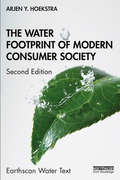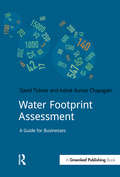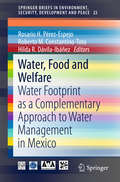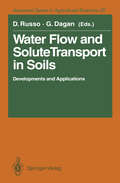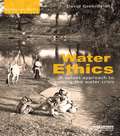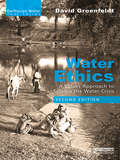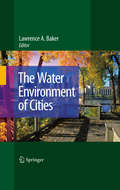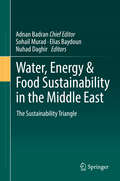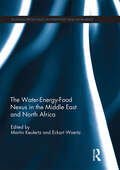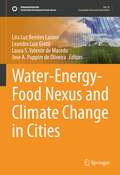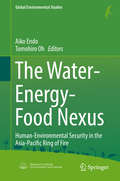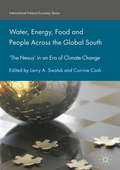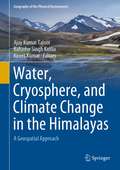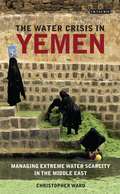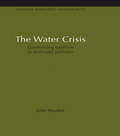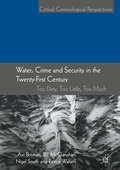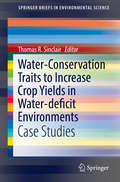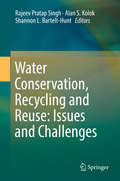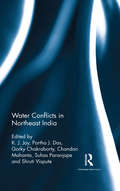- Table View
- List View
The Water Footprint of Modern Consumer Society (Earthscan Water Text)
by Arjen Y. HoekstraUsing the water footprint concept, this impactful book aids our understanding of how we can reduce water consumption and pollution to sustainable levels. Since the publication of the first edition, the question of how to reduce our water footprint has become even more urgent. Freshwater scarcity is increasingly perceived as a global systemic risk and overconsumption of water is widespread. The water footprint, a concept founded by the author, is an indicator of direct and indirect freshwater use by a consumer or producer that can be used to analyze water usage along supply chains and assess the sustainability, efficiency and fairness of our water use. This new edition is fully revised and updated to reflect continued developments in this rapidly growing field of knowledge. New chapters are added covering the history of the water footprint concept; the environmental footprint of the human species versus planetary boundaries; and the human right to water as a foundation to equitable sharing. All other chapters are fully revised with new findings, applications and references, including major new research on energy, vegetarian diets and intelligent water allocation over competing demands. The Water Footprint of Modern Consumer Society is a key textbook for students of interdisciplinary water studies and those taking other related courses within the environmental sciences. It will also be of interest to those working in the governmental sector, environmental and consumer organizations, the business sector and UN institutions, where there is growing interest in the water footprint concept.
Water Footprint Assessment: A Guide for Business
by David Tickner Ashok Kumar ChapagainAs business risks associated with water intensify – for example risks to oeprations, supply chains and reputation – many corporate sustainability professionals are seeking practical tools to help them understand and assess these risks. Water Footprint Assessment tools developed primarily by the research sector are gaining attention in this context. However, there is debate among experts and non-experts about the merits of this approach. Water Footprint Assessment: A Business Guide is a concise and comprehensive digest of emerging concepts, tools and arguments around water footprint approaches. Specifically aimed at business audiences, this definitive short guide to the issues distils the latest in scientific and policy literature, helps sustainability leaders understand what they can, and can't do with water footprint tools, includes practical experience and case studies and outlines the pros and cons of using Water Footprint Assessment and similar approaches.
Water Footprint Assessment: A Guide for Business (Doshorts Ser.)
by David Tickner Ashok Kumar ChapagainAs business risks associated with water intensify – for example risks to oeprations, supply chains and reputation – many corporate sustainability professionals are seeking practical tools to help them understand and assess these risks. Water Footprint Assessment tools developed primarily by the research sector are gaining attention in this context. However, there is debate among experts and non-experts about the merits of this approach. Water Footprint Assessment: A Business Guide is a concise and comprehensive digest of emerging concepts, tools and arguments around water footprint approaches. Specifically aimed at business audiences, this definitive short guide to the issues distils the latest in scientific and policy literature, helps sustainability leaders understand what they can, and can't do with water footprint tools, includes practical experience and case studies and outlines the pros and cons of using Water Footprint Assessment and similar approaches.
Water, Food and Welfare: Water Footprint as a Complementary Approach to Water Management in Mexico (SpringerBriefs in Environment, Security, Development and Peace #23)
by Rosario Pérez-Espejo Roberto M. Constantino-Toto Hilda R. Dávila-IbáñezThis book addresses the following topics: the contemporary model for water management and alternative approaches; the socioeconomic framework, water policy and institutions; water use for food purposes, water-resources inventory and irrigation; manifestations of welfare loss and water prices; change in dietary patterns and water security; hydrological stress and pressures on water availability; groundwater management problems; vulnerability and climate change; water demand of major crops; gray water footprint and water pollution; gray water footprint and mining; virtual water and food trade; estimates of the water footprint of four key cereals, forage, livestock and bottled drinks. It is the result of a cooperation between 16 researchers from eleven Mexican academic institutions.
Water Flow and Solute Transport in Soils: Developments and Applications In Memoriam Eshel Bresler (1930–1991) (Advanced Series in Agricultural Sciences #20)
by David Russo Gedeon DaganA year has passed since Eshel Bresler, my good friend and colleague, and a member of the editorial board of the Advanced Series in Agricultural Sciences, died suddenly while on a visit to the Chinese Academy of Sciences in Beijing. We had worked together for almost 30 years at the Institute of Soils and Water, ARO, The Volcani Center at Bet Dagan. At the very beginning of our scientific careers we cooperated directly and as a result one of our first publications was coauthored (Soil Sci. 101:205-209, 1966). Thereafter, our specific research interests diver sified, but we continued to work together, with similar approaches to research, and to strive towards the development of Israel soil science and its integration into general worldwide scientific progress. I don't need to emphasize Eshel's contribution to the understan ding of the processes governing water flow and solute transport pro cesses in soils and unsaturated zones. The contributions to this Volume by such a body of outstanding scientists shows the apprecia tion of the international scientific community to his research achievements.
Water Ethics: A Values Approach to Solving the Water Crisis
by David GroenfeldtThis book introduces the idea that ethics are an intrinsic dimension of any water policy, program, or practice, and that understanding what ethics are being acted out in water policies is fundamental to an understanding of water resource management. Thus in controversies or conflicts over water resource allocation and use, an examination of ethics can help clarify the positions of conflicting parties as preparation for constructive negotiations. The author shows the benefits of exposing tacit values and motivations and subjecting these to explicit public scrutiny where the values themselves can be debated. The aim of such a process is to create the proverbial 'level playing field', where values favoring environmental sustainability are considered in relation to values favoring short-term exploitation for quick economic stimulus (the current problem) or quick protection from water disasters (through infrastructure which science suggests is not sustainable). The book shows how new technologies, such as drip irrigation, or governance structures, such as river basin organizations are neither "good" nor "bad" in their own right, but can serve a range of interests which are guided by ethics. A new ethic of coexistence and synergies with nature is possible, but ultimately depends not on science, law, or finances but on the values we choose to adopt. The book includes a wide range of case studies from countries including Australia, India, Philippines, South Africa and USA. These cover various contexts including water for agriculture, urban, domestic and industrial use, the rights of indigenous people and river, watershed and ecosystem management.
Water Ethics: A Values Approach to Solving the Water Crisis
by David GroenfeldtThis book introduces the idea that ethics are an intrinsic dimension of any water policy, program, or practice, and that understanding what ethics are being acted out in water policies is fundamental to an understanding of water resource management. Thus in controversies or conflicts over water resource allocation and use, an examination of ethics can help clarify the positions of conflicting parties as preparation for constructive negotiations. The author shows the benefits of exposing tacit values and motivations and subjecting these to explicit public scrutiny where the values themselves can be debated. The aim of such a process is to create the proverbial 'level playing field', where values favoring environmental sustainability are considered in relation to values favoring short-term exploitation for quick economic stimulus (the current problem) or quick protection from water disasters (through infrastructure which science suggests is not sustainable). The book shows how new technologies, such as drip irrigation, or governance structures, such as river basin organizations are neither "good" nor "bad" in their own right, but can serve a range of interests which are guided by ethics. A new ethic of coexistence and synergies with nature is possible, but ultimately depends not on science, law, or finances but on the values we choose to adopt. The book includes a wide range of case studies from countries including Australia, India, Philippines, South Africa and USA. These cover various contexts including water for agriculture, urban, domestic and industrial use, the rights of indigenous people and river, watershed and ecosystem management.
Water Ethics: A Values Approach to Solving the Water Crisis (Earthscan Water Text)
by David GroenfeldtFully revised and updated, this second edition of Water Ethics continues to consolidate water ethics as a key dimension of water-related decisions. The book introduces the idea that ethics are an intrinsic dimension of any water policy, program, or practice, and that understanding what ethics are being acted out in water policies is fundamental to an understanding of water resource management. Alongside updated references and the introduction of discussion questions and recommended further reading, this new edition discusses in depth three significant developments since the publication of the first edition in 2013. The first is the growing awareness of the climate crisis as an existential threat, and associated concern about adaptive strategies for sustainable water management and ways of using water management for climate mitigation (e.g., practically through agricultural soil management and conceptually through ethics awareness). Second, there has been increased clarity among the religious community, Indigenous leaders, and progressive academics that ethics needs to become an arena for application and action (e.g., the Vatican encyclical Laudato Si, protests at Standing Rock and Flint, Michigan, in the US, and climate demonstrations worldwide). Thirdly, there have been new normative water standards ranging from "water stewardship" (industry initiative), water charters (Berlin) and the on-going initiative to develop a global water ethics charter. Drawing on case studies from countries including Australia, India, the Philippines, South Africa, and the United States, this textbook is essential reading for students of environmental ethics and water governance and management.
Water Ethics: A Values Approach to Solving the Water Crisis (Earthscan Water Text)
by David GroenfeldtFully revised and updated, this second edition of Water Ethics continues to consolidate water ethics as a key dimension of water-related decisions. The book introduces the idea that ethics are an intrinsic dimension of any water policy, program, or practice, and that understanding what ethics are being acted out in water policies is fundamental to an understanding of water resource management. Alongside updated references and the introduction of discussion questions and recommended further reading, this new edition discusses in depth three significant developments since the publication of the first edition in 2013. The first is the growing awareness of the climate crisis as an existential threat, and associated concern about adaptive strategies for sustainable water management and ways of using water management for climate mitigation (e.g., practically through agricultural soil management and conceptually through ethics awareness). Second, there has been increased clarity among the religious community, Indigenous leaders, and progressive academics that ethics needs to become an arena for application and action (e.g., the Vatican encyclical Laudato Si, protests at Standing Rock and Flint, Michigan, in the US, and climate demonstrations worldwide). Thirdly, there have been new normative water standards ranging from "water stewardship" (industry initiative), water charters (Berlin) and the on-going initiative to develop a global water ethics charter. Drawing on case studies from countries including Australia, India, the Philippines, South Africa, and the United States, this textbook is essential reading for students of environmental ethics and water governance and management.
The Water Environment of Cities
by Lawrence A. BakerThe concept for the Water Environment of Cities arose from a workshop “Green 1 Cities, Blue Waters” workshop held in 2006. The workshop assembled experts from engineering, planning, economics, law, hydrology, aquatic ecology, geom- phology, and other disciplines to present research ?ndings and identify key new ideas on the urban water environment. At a lunch discussion near the end of the workshop, several of us came to the recognition that despite having considerable expertise in a narrow discipline, none of us had a vision of the “urban water en- ronment” as a whole. We were, as in the parable, blind men at opposite ends of the elephant, knowinga great deal about the parts, but notunderstandingthe whole. We quickly recognized the need to develop a book that would integrate this knowledge to create this vision. The goal was to develop a book that could be used to teach a complete, multidisciplinary course, “The Urban Water Environment”, but could also be used as a supplemental text for courses on urban ecosystems, urban design, landscapearchitecture,water policy,waterqualitymanagement andwatershed m- agement. The book is also valuable as a reference source for water professionals stepping outside their arena of disciplinary expertise. The Water Environment of Cities is the ?rst book to use a holistic, interdis- plinary approach to examine the urban water environment. We have attempted to portrayaholisticvisionbuiltaround theconcept of water as a coreelement ofcities. Water has multipleroles:municipalwatersupply,aquatichabitat,landscapeaesth- ics, and recreation. Increasingly, urban water is reused, serving multiple purposes.
Water, Energy & Food Sustainability in the Middle East: The Sustainability Triangle
by Adnan Badran Sohail Murad Elias Baydoun Nuhad DaghirThis book provides a survey of technologies available to tackle the problems associated with climate change in the energy, water and food security nexus with a special focus on the Middle East. It is divided into three main sections. The energy Section consists of six chapters, the water section of seven chapters and finally the food security section has six chapters. The individual chapters are authored by experts and provide discussions and in-depth views on the current status of each topic.
The Water-Energy-Food Nexus in the Middle East and North Africa (Routledge Special Issues on Water Policy and Governance)
by Martin Keulertz Eckart WoertzThis book discusses key issues concerning water, energy and food in the Middle East and North Africa (MENA) region. It provides an interdisciplinary account of current developments in the most water-scarce and conflict-torn region in the world. Key analysts on MENA water, agriculture and energy affairs have been drawn together to compile one of the first edited volumes dedicated to the crucial role of water, energy and food security in the 21st century MENA region. It will be of interest to decision-makers, analysts and students of the future of the Middle East from a broad range of disciplines including the physical and social sciences. This book was previously published as a special issue of the International Journal of Water Resources Development.
The Water-Energy-Food Nexus in the Middle East and North Africa (Routledge Special Issues on Water Policy and Governance)
by Martin Keulertz Eckart WoertzThis book discusses key issues concerning water, energy and food in the Middle East and North Africa (MENA) region. It provides an interdisciplinary account of current developments in the most water-scarce and conflict-torn region in the world. Key analysts on MENA water, agriculture and energy affairs have been drawn together to compile one of the first edited volumes dedicated to the crucial role of water, energy and food security in the 21st century MENA region. It will be of interest to decision-makers, analysts and students of the future of the Middle East from a broad range of disciplines including the physical and social sciences. This book was previously published as a special issue of the International Journal of Water Resources Development.
Water-Energy-Food Nexus and Climate Change in Cities (Sustainable Development Goals Series)
by Lira Luz Benites Lazaro Leandro Luiz Giatti Laura S. Valente de Macedo Jose A. Puppim de OliveiraThis book aims to contribute to the transdisciplinary study of the water-energy-food (WEF) nexus in cities and to help policy makers adopt a more integrated approach to natural resources management in urban environments to face the challenges and threats of climate change. This approach is based on a multidimensional scientific framework that seeks to understand the complex and non-linear interrelationships and interdependencies between water-energy-food under climate change and to generate solutions to reduce trade-offs among development goals and generate co-benefits that help encourage sustainable development and contribute to the achievement of SDGs, mainly SDG 11 (make cities and human settlements inclusive, safe, resilient and sustainable) and SDG 13 (take urgent action to combat climate change and its impacts).Governing the WEF nexus in cities is one of the greatest resource challenges of our time, as cities consume large amounts of WEF, but one that can also generate relevant alternatives with which to tackle climate change. To help fostering these alternatives, this book analyzes the governance, institutional and political economy factors that determine the effectiveness of the nexus approach and reviews the potential, the benefits and the policy implications of the adoption of the WEF nexus approach at the urban level. Through a series of hands-on cases, chapters in this book present the opportunities of the WEF nexus approach to achieve innovation and transformative change and discuss concrete areas of synergy and policy initiative to raise urban resilience. Water-Energy-Food Nexus and Climate Change in Cities will serve both as a guide for policy makers as well as a useful resource for students and researchers in fields such as urban studies, public health, environmental sciences, energy studies and public policy interested in learning how cities can represent possibilities to navigate and manage sustainability from local to global.
The Water-Energy-Food Nexus: Human-Environmental Security in the Asia-Pacific Ring of Fire (Global Environmental Studies)
by Aiko Endo Tomohiro OhThis book highlights the water-energy-food nexus as one of the most important and fundamental global environmental issues facing the world. Climate and social changes are putting increased pressure on water, energy and food resources. As water is the central aspect within this cluster, the book focuses on the inherent tradeoffs in water resources between producing/consuming energy and food. In addition, it discusses an inter- and trans-disciplinary approach to understanding the complexity of the water-energy-food nexus system, and creating policy options to reduce the tradeoffs among resources. The content integrates a variety of academic disciplines, including not only the natural sciences (e.g. hydrology, coastal oceanography, costal aquatic bioscience, fisheries, environmental earth science etc.) but also the humanities and social sciences (e.g. marine policy, environmental energy policy, resource governance, policy process theory etc.). The book can be used as a textbook for undergraduate and graduate-level sustainability science courses. Further, its practical content and trans-disciplinary approach to addressing nexus issues with stakeholders offers vital information for practitioners and administrators alike.
Water, Energy, Food and People Across the Global South
by Larry A. Swatuk Corrine CashThis collection critically engages the resource use nexus. Clearly, a nexus-approach to resource policy, planning and practice is essential if sustainable development goals are to be met. In particular, in an era of climate change, an integrated approach to water, energy and agriculture is imperative. Agriculture accounts for 70% of global water withdrawals, food production accounts for 30% of global energy use and a rising global population requires more of everything. As shown in this collection, scholars of resource development, governance and management are 'nexus sensitive', utilizing a sort of 'nexus sensibility' in their work as it focuses on the needs of people particularly, but not only, in the global South. Importantly, a nexus-approach presents academics and practitioners with a discursive space in which to shape policy through research, to deepen and improve understandings of the interconnections and impacts of particular types of resource use, and to critically reflect on actions taken in the name of the 'nexus'.
Water, Energy, Food and People Across the Global South: ‘The Nexus’ in an Era of Climate Change
by Larry A. Swatuk Corrine CashThis collection critically engages the resource use nexus. Clearly, a nexus-approach to resource policy, planning and practice is essential if sustainable development goals are to be met. In particular, in an era of climate change, an integrated approach to water, energy and agriculture is imperative. Agriculture accounts for 70% of global water withdrawals, food production accounts for 30% of global energy use and a rising global population requires more of everything. As shown in this collection, scholars of resource development, governance and management are ‘nexus sensitive’, utilizing a sort of ‘nexus sensibility’ in their work as it focuses on the needs of people particularly, but not only, in the global South. Importantly, a nexus-approach presents academics and practitioners with a discursive space in which to shape policy through research, to deepen and improve understandings of the interconnections and impacts of particular types of resource use, and to critically reflect on actions taken in the name of the ‘nexus’.
Water, Cryosphere, and Climate Change in the Himalayas: A Geospatial Approach (Geography of the Physical Environment)
by Ajay Kumar Taloor Bahadur Singh Kotlia Kireet KumarThis edited book summarizes numerous research studies on remote sensing and GIS of natural resource management for the Himalaya region done by Indian Institutions and Universities over the last decade. It gives an overview of hydrometeorological studies on Himalayan water resources and addresses concerns in the development of water resources in this region, which is dealing with an increased pressure in population, industrialization and economic development. While the source of some of the major rivers of India are found in the Himalayas, the glaciers and water bodies in the region are continuously shrinking leading to a depletion of water and deterioration of water quality. This is affecting a population of up to 2.5 billion people. The ecosystems have been under threat due to deforestation, loss of biodiversity, expansion of agriculture and settlement, overexploitation of natural resources, habitat loss and fragmentation, poaching, mining, construction of roads and large dams, and unplanned tourism. Spaceborne remote sensing with its ability to provide synoptic and repetitive coverage has emerged as a powerful tool for assessment and monitoring of the Himalayan resources and phenomena. This work serves as a resource to students, researchers, scientists, professionals, and policy makers both in India and on a global level.
The Water Crisis in Yemen: Managing Extreme Water Scarcity in the Middle East (International Library of Human Geography)
by Christopher WardSince the 1970s Yemen has undergone rapid social and economic change. But the creation of the modern state has come at a cost, and the country has fallen into a severe water crisis. Groundwater is being extracted at such a rate that parts of the rural economy could disappear within a generation. In no other country in the Middle East are the aquifers being exhausted so quickly. Christopher Ward provides the first comprehensive study of the water management crisis in Yemen and presents a complete analysis, covering the institutional, environmental, technical and political economy components. He assesses the social and economic impacts of the crisis and provides in-depth case studies in the key management areas: water resources management; agricultural water management and irrigation; urban water supply and sanitation; and rural water supply and sanitation. He examines the range of policy and programme responses to date and explores their largely unsuccessful outcomes. In the final part of the book the author evaluates the current strategy and looks at future ways in which the people of the country and their government can influence outcomes and make the transition to a sustainable water economy. Combining a historical perspective and an interdisciplinary approach, The Water Crisis in Yemen draws on both new field research and a very wide set of official and unofficial information sources, much of it being made available for the first time. The result offers a comprehensive, practical and effective approach to achieving sustainable and equitable water management in a country whose water problems are amongst the most serious in the world.
The Water Crisis: Constructing solutions to freshwater pollution
by Julie StaufferModern society too often views water as a convenient vehicle for disposing of waste � and the results are becoming increasingly apparent. Analysis of freshwater supplies frequently reveals disturbing levels of pollution, including human waste, heavy metals and synthetic chemicals, to the detriment of our health, and the health of entire ecosystems. The Water Crisis examines the roots of freshwater pollution � urbanization, industrialization and intensive farming � supported by case studies from the Rhine and the Great Lakes. It explores the impact of major pollutants and discusses methods of prevention. The final section provides a detailed overview of possible solutions, including soil-based treatment systems and constructed wetlands. A separate chapter is devoted to the important issue of groundwater pollution. Practical concise and accessible, this is ideal for students in environmental studies and environmental science, biology and geography, and general readers. Originally published in 1998
The Water Crisis: Constructing solutions to freshwater pollution (Natural Resource Management Set Ser.)
by Julie StaufferModern society too often views water as a convenient vehicle for disposing of waste � and the results are becoming increasingly apparent. Analysis of freshwater supplies frequently reveals disturbing levels of pollution, including human waste, heavy metals and synthetic chemicals, to the detriment of our health, and the health of entire ecosystems. The Water Crisis examines the roots of freshwater pollution � urbanization, industrialization and intensive farming � supported by case studies from the Rhine and the Great Lakes. It explores the impact of major pollutants and discusses methods of prevention. The final section provides a detailed overview of possible solutions, including soil-based treatment systems and constructed wetlands. A separate chapter is devoted to the important issue of groundwater pollution. Practical concise and accessible, this is ideal for students in environmental studies and environmental science, biology and geography, and general readers. Originally published in 1998
Water, Crime and Security in the Twenty-First Century: Too Dirty, Too Little, Too Much (Critical Criminological Perspectives )
by Avi Brisman Nigel South Reece Walters Bill McClanahanCritical Criminological Perspectives Ser.
Water-Conservation Traits to Increase Crop Yields in Water-deficit Environments: Case Studies (SpringerBriefs in Environmental Science)
by Thomas R. SinclairThis volume explores specific approaches that have shown to result in crop yield increases. Research on the physiological understanding of these methods has led to the development of practical applications of plant breeding approaches to genetically improve crops to achieve higher yields. Authoritative entries from crop scientists shed new light on two water-conservation traits: one that is based on an initiation of the decrease in transpiration earlier in the soil drying cycle, and the second that is based on a sensitivity of transpiration rate under high atmospheric vapor pressure deficit that results in partial stomatal closure. Both these approaches involve partial stomatal closure under well-defined situations to decrease the rate of soil water loss. Readers will be able to analyze the circumstances under which a benefit is achieved as a result of the water-limitation trait; and key discussion points in the case studies presented will help answer questions such as what species, which environments, how often will yield be benefited for various crop species? Contributions also review the genetic variation for these two traits within each crop species and the physiological basis for the expression of these traits.
Water Conservation, Recycling and Reuse: Issues and Challenges
by Rajeev Pratap Singh Alan S. Kolok Shannon L. Bartelt-HuntWater - a basic element of life, livelihood, food security and sustainable development - holds the key to global sustainability. The global water demand has been increased 3-fold in the past five decades and only 0.4% of the total world’s fresh water resources is available and accessible for use. The United Nations projected that half of all countries will face water scarcity by 2025 and more than one-third of the world’s population could be affected by water stress by 2050. The water problem is rapidly intensifying in the Asian region, and around 700 million people do not have access to safe drinking water. Similarly, according to the Intergovernmental Panel on Climate Change (IPCC) report, by 2050, more than one billion people in Asia alone are projected to experience negative impacts on water resources as a result of climate change. Climate change is also putting extra pressure on and adversely affecting the global water cycle, leading to irregular precipitation, more floods and droughts and creating an imbalance between water supply and demand. The availability of safe water is a major global concern due to the rapidly increasing population, urbanization, unsustainable consumption patterns, and rapid shifts in land use. It is believed that reduced access to freshwater will have cascading consequences that will pose threat to global food security, livelihood security, and cause large scale migration and economic and geopolitical tensions. As such, strategies for water conservation, wastewater reuse and recycling should be adopted in order to lessen the gap between supply and demand for water for different activities. This book provides readers with a better understanding of the water security challenges, and presents innovations to address these challenges, strengthen the science-policy interface, and develop institutional and human capacities for water security and sustainability.
Water Conflicts in Northeast India
by K. J. Joy Partha J. Das Gorky Chakraborty Chandan Mahanta Suhas Paranjape Shruti VisputeNortheast India, apart from being the rainiest in India, is drained by two large river systems of the world – the Brahmaputra and the Barak (Meghna) – both transnational rivers cutting across bordering countries. The region, known for its rich water resources, has been witnessing an increasing number of conflicts related to water in recent years. This volume documents the multifaceted conflicts and contestations around water in Northeast India, analyses their causes and consequences, and includes expert recommendations. It fills a major gap in the subject by examining wide-ranging issues such as cultural and anthropological dimensions of damming rivers in the Northeast and Eastern Himalayas; seismic surveys, oil extractions, and water conflicts; discontent over water quality and drinking water; floods, river bank erosion, embankments; water policy; transboundary water conflicts; and hydropower development. It also discusses the alleged Chinese efforts to divert the Brahmaputra River. With its analytical and comprehensive coverage, 18 case studies, and suggested approaches for conflict resolution, this book will be indispensable for scholars and researchers of development studies, governance and public policy, politics and international relations, water resources, environment, geography, climate change, area studies, economics, and sociology. It will also be an important resource for policymakers, bureaucrats, development practitioners, civil society groups, the judiciary, and media.
